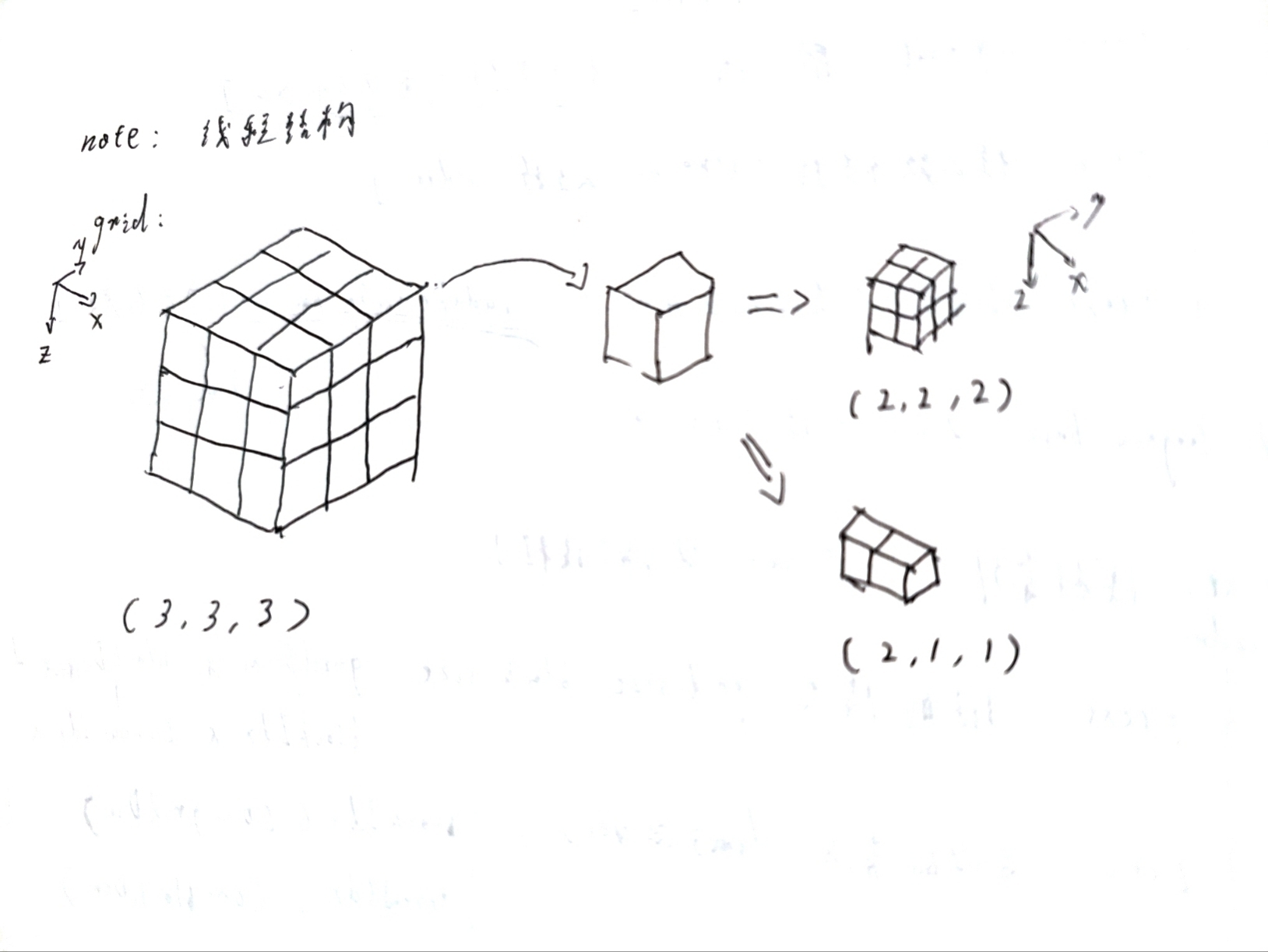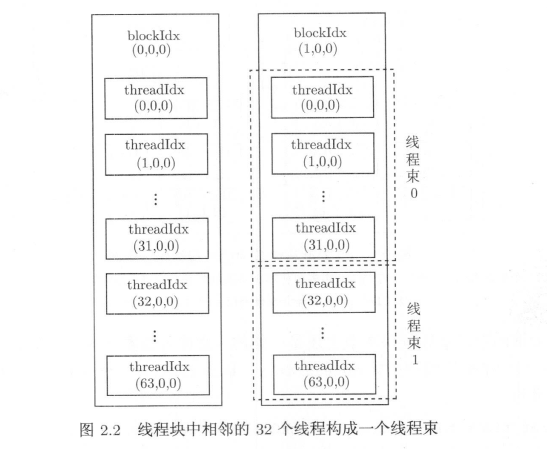简述CUDA的线程结构-以HelloWorld为例
万物化作,萌区有状,盛衰之杀,变化之流也。
本文以helloworld为例,简述CUDA的线程结构
基本概念
即使是HelloWorld,Cuda程序也引入了一些不同的概念,确保了解《简略CUDA和GPU相关概念》中的内容在进行下去
从HelloWorld开始
下面是一个最简单的HelloWorld程序:
/**
运行命令: cl ./hello_host_only.cpp
**/
#include <cstdio>
using namespace std;
int main() {
printf("Host: Hello wolrd!");
return 0;
}在windows可在x64 Native Tools Command Prompt for VS 2022用cl来编译它
只有Host代码的CUDA版本HelloWolrd
/**
运行命令: nvcc -arch=sm_62 hello_host_only.cu
sm_62的来源:
https://docs.nvidia.com/cuda/archive/12.9.0/cuda-compiler-driver-nvcc/index.html
https://en.wikipedia.org/wiki/CUDA#GPUs_supported
*/
#include <cstdio>
using namespace std;
int main() {
printf("Host: Hello wolrd!");
return 0;
}代码完全没有变化,只有文件后缀名发生了变化
但这里性质发生了变化,代码分为了Host代码部分和Device代码部分由nvcc分别处理
nvcc指定运算架构
注意到注释部分,nvcc可以指定虚拟和真实架构的编号,可以通过链接查看本地设备可以使用的标识
如果需要匹配多个架构,可以使用多个-gencode -arch 虚拟架构 -code 真实架构来编译产生不同的输出,最后真实架构不能落后与虚拟架构
使用CUDA线程
从这里正式开始添加Device代码:
/**
运行命令: nvcc XX.cu
*/
#include<cuda.h>
#include<cuda_runtime.h>
#include<cstdio>
__global__ void hello_from_gpu()
{
printf("Device: Hello World.");
}
int main()
{
const int grid_size=1;
const int block_size=1;
hello_from_gpu<<<grid_size,block_size>>>();
cudaDeviceSynchronize();
return 0;
}注意四点:
- include包含了两个cuda相关头文件,这不是必须要添加的,nvcc会自动引入,其中包含了cstdlib的内容,但没有包含cstdio的内容,最后device程序是不认iostream的
__global___就是device代码,即核函数的标志cudaDeviceSynchronize的功能是同步host和device,也就是说gpu上的代码和cpu上的代码是异步运行的<<<grid_size,block_size>>>指定了用多少线程运行该核函数
使用多线程的CUDA程序
再进一步改进程序
/**
运行命令: nvcc XX.cu
*/
#include<cuda.h>
#include<cuda_runtime.h>
#include<cstdio>
__global__ void hello_from_gpu()
{
const int bid = blockIdx.x;
const int tid = threadIdx.x;
printf("Device: Hello World from block %d and thread %d\n",bid,tid);
}
int main()
{
const int grid_size=2;
const int block_size=4;
hello_from_gpu<<<grid_size,block_size>>>();
cudaDeviceSynchronize();
return 0;
}CUDA将线程组织为网格,网格被划分为线程块,即网格由线程块组成,线程块由线程组成,三者之间并不是简单的包含关系(即一般论的包含关系,网格有N个线程块,每个线程块又有M个线程),但是目前示例中确实只是单纯的包含关系,可简单认为有网格两个线程块,每个线程块四个线程共八个线程
下图展示了多维线程的布局,这也是网格的真正分布:

可以认为网格是一个三维立方体,被划分出的小格就是线程块,而小格又可以按三维继续分割,分割出的就是线程。
像上面简单的以2和4指定的线程块个数和线程个数,三维上可以分别认为是(2,1,1)和(4,1,1),只按x轴延伸的2个大方块,每个大方块又是由按x轴延展的4个小方块组成
多维线程的CUDA程序
既然有了三维建构,每个线程块和线程自然有其三维坐标,按照简单的数学逻辑也可以转换为1维坐标,这里直接把这些概念在代码中展示:
/**
运行命令: nvcc XX.cu
*/
#include<cuda.h>
#include<cuda_runtime.h>
#include<cstdio>
__global__ void hello_from_gpu()
{
const int bid = blockIdx.x;
const int tid_x = threadIdx.x;
const int tid_y = threadIdx.y;
const int tid_z = threadIdx.z;
//1D坐标:
const int bid_1D = blockIdx.x+blockIdx.y*gridDim.x+blockIdx.z*gridDim.x*gridDim.y;
const int tid_1D = threadIdx.x + blockDim.x*threadIdx.y + blockDim.x*blockDim.y*threadIdx.z;
printf("Device(%d)(%d): Hello World from block %d and thread (%d-%d-%d)\n",bid_1D,tid_1D,bid,tid_x,tid_y,tid_z);
}
int main()
{
const int grid_size=2;
const dim3 block_size(3,3,3);
hello_from_gpu<<<grid_size,block_size>>>();
cudaDeviceSynchronize();
return 0;
}注意到:
- dim3类似于vec3,表3维向量
- gridDim和blockDim是dim3固有变量,内容是当初规定的各个轴的上限
- blockIdx和threadIdx也是dim3固有变量,包含了当前线程的坐标
另外,线程块在3个轴上的个数和一个线程块的线程数是有限制的:
- 线程块在xyz三轴上分别最多:
2^31-1,65535,65535 - 一个线程块线程总数最多1024,在三维上最多:
1024,1024,64
下面是超过了限制的程序:
/**
运行命令: nvcc XX.cu
*/
#include<cuda.h>
#include<cuda_runtime.h>
#include<cstdio>
__global__ void hello_from_gpu()
{
const int bid = blockIdx.x;
const int tid_x = threadIdx.x;
const int tid_y = threadIdx.y;
const int tid_z = threadIdx.z;
//1D坐标:
const int bid_1D = blockIdx.x+blockIdx.y*gridDim.x+blockIdx.z*gridDim.x*gridDim.y;
const int tid_1D = threadIdx.x + blockDim.x*threadIdx.y + blockDim.x*blockDim.y*threadIdx.z;
printf("Device(%d)(%d): Hello World from block %d and thread (%d-%d-%d)\n",bid_1D,tid_1D,bid,tid_x,tid_y,tid_z);
}
int main()
{
const dim3 grid_size(1,65535,1); //大于规定的2^31-1,65535,65535范围虽然能通过编译,但没有输出
const dim3 block_size(1024,1,1); //大于1024虽然能通过编译,但没有输出
hello_from_gpu<<<grid_size,block_size>>>();
cudaDeviceSynchronize();
return 0;
}线程束
还有一个没有在代码中体现出的概念:线程束,简单理解为同一线程块中相邻的N个线程,一般按架构为32个一组
